The Pizza-Filled History of Drive-in Movie Theaters
+ Why we eat Snacks, Za, and Fast Food at the Movies
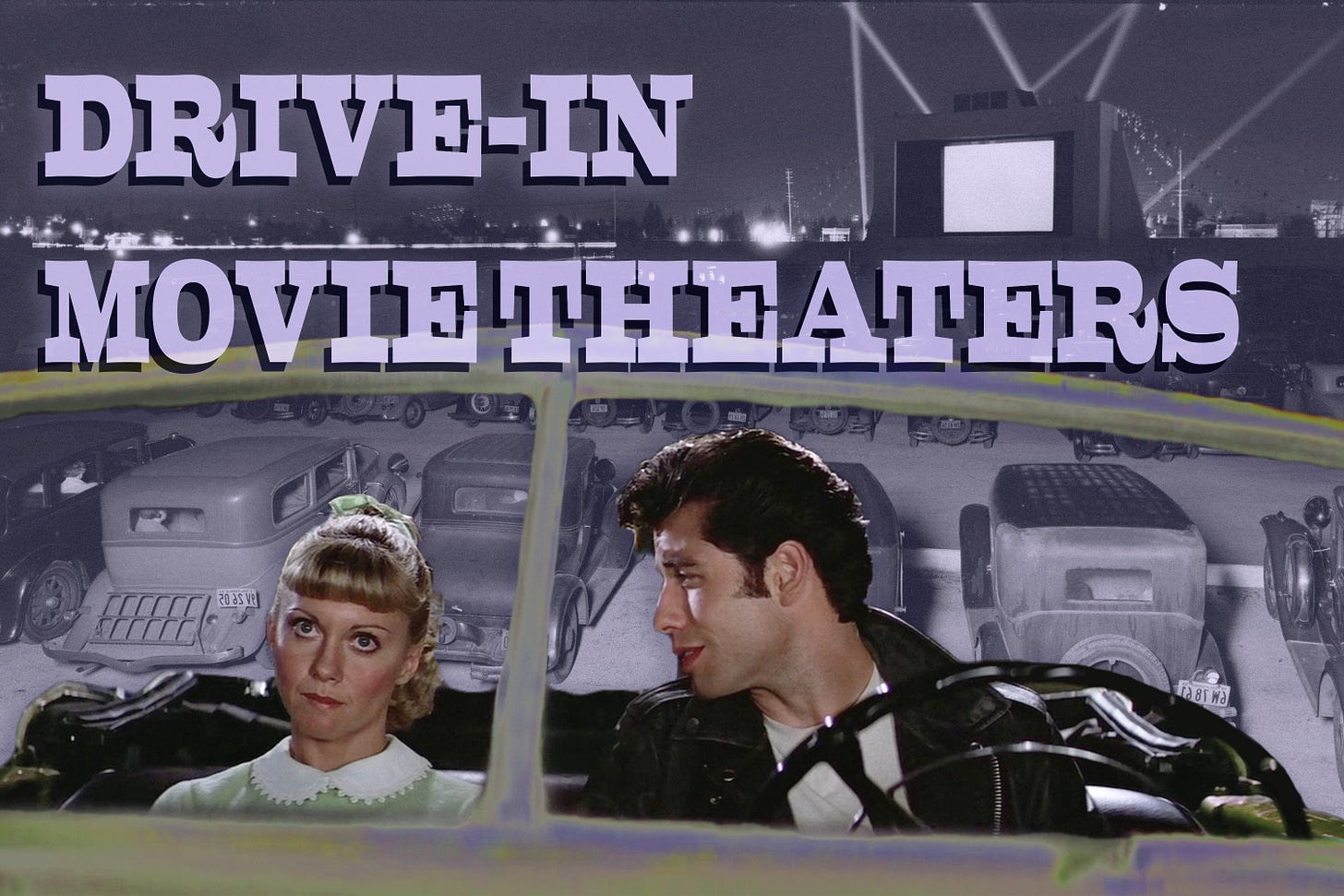
Here at Film Flavor, we’ve covered the history of movie theater concessions, candy, and even answered the question: Why do we eat popcorn at movie theaters?
Now, Film Flavor attempts to answer another popular food-film query: Why do we eat pizzas and hot dogs at the movie theater?
The short answer: We have drive-in movie theaters to thank.
The long answer requires a look back at the history of drive-in movie theaters, intermissions, and concessions. (Fear not, for there are lots of hilarious vintage drive-in intermission videos ahead.) Grab your refreshment of choice, sit back, and scroll through the mouthwatering history below.
Disclaimer: Film Flavor is a newsletter written for entertainment purposes only. While I do my best to write meaningful posts with good intentions and cite sources when I have the bandwidth, I do not have the capacity nor the expertise to fact-check research as a trained professional journalist would. Despite my best efforts, the Film Flavor newsletter may contain omissions, errors, or mistakes and cannot be relied upon for accuracy or correctness. Additionally, I am not a chef, doctor, nutritionist, or food professional, and it is the responsibility of the reader to consult qualified professionals and use good judgement to decide whether the ingredients, foods, drinks, recipes, and cooking instructions mentioned within Film Flavor are safe to use, follow, or consume. The Film Flavor newsletter does not contain any professional advice or guidance and its contents should not be considered as such. Read the full Film Flavor disclaimer on the Film Flavor About Page, here. Thank you!
The First Drive-In Movie Theaters
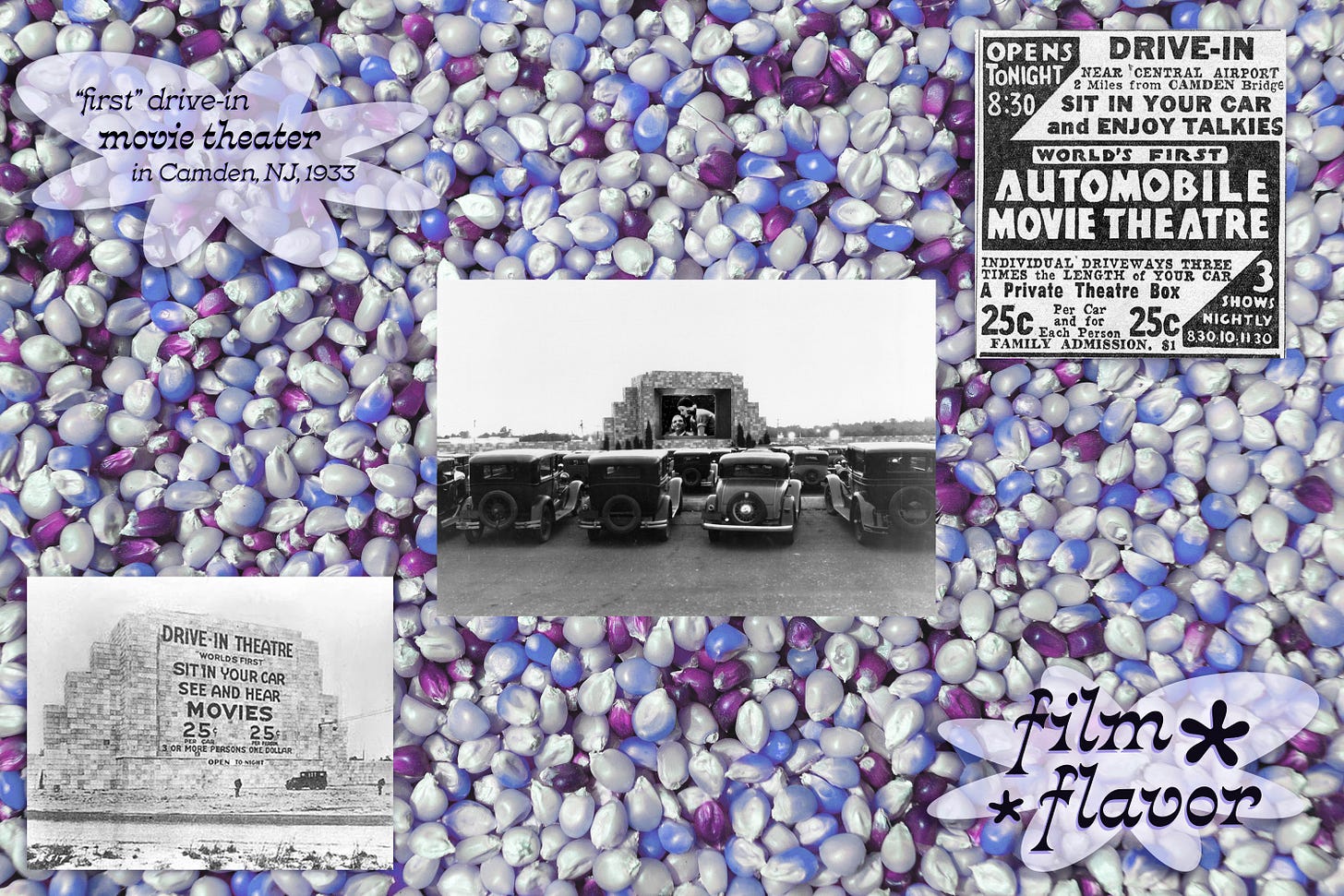
Historians debate which theater was the first to allow patrons to drive up in their cars and watch movies under the starry night sky.
Contrary to popular belief: Filmmaker, historian, author, and all-around swell-sounding guy David G. Thomas recently unearthed compelling evidence showing the first open-air, drive-in movie theater opened in Las Cruces, New Mexico in the summer of 1914.
According to Thomas’s book, Screen with a Voice, movie theater owner Roline e. Banner opened an “Open Air Picture Show” with an undocumented seating style. Were they sitting on picnic blankets, seats, or in their very own automobiles? All we know is that this event prompted another local theater — the Airdome — to close its facilities and open a new open-air location in a matter of weeks, with seats for patrons as well as an “automobile drive” allowing customers “to see the performance without leaving the cars.”1
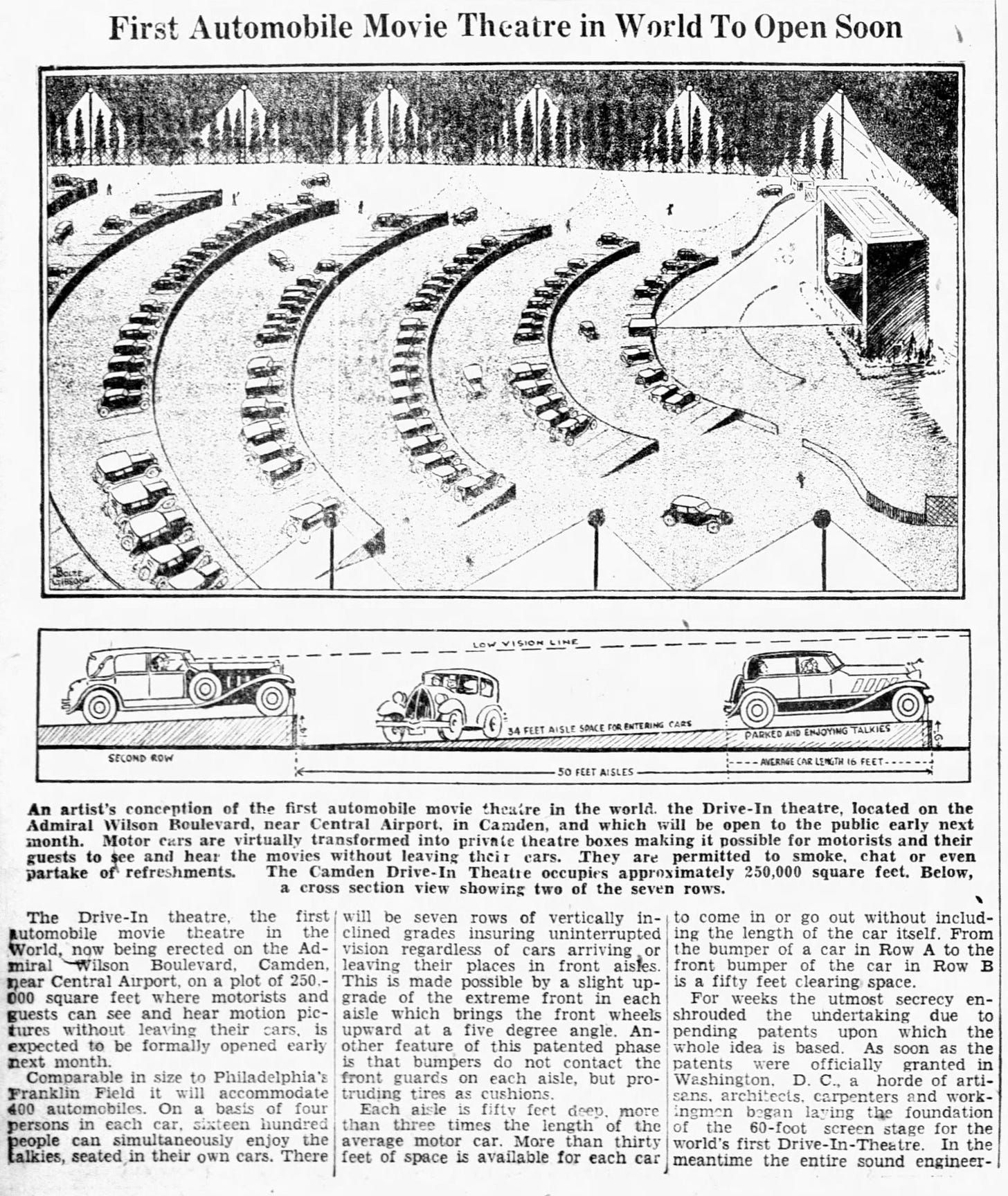
Even so, the invention patent for drive-in movie theaters was only filed in 1933, by Richard M. Hollingshead Jr. After experimenting with an at-home drive-in set up for his mother — who was allegedly too large to sit comfortably in typical movie theater seats of the time — Hollingshead had a vision. Utilizing R.C.A. photophone speakers and a ramp-tiered parking design (pictured above), Hollingshead specifically designed the theater to have clear sightlines and privacy for all attendees. By June 6th, 1933, the first “official” drive-in movie theater opened its doors (...or should I say “driveway”?)
It was easy to see the appeal: With drive-in cinemas, there was no need to stand up to make way for late patrons, and no need to get to the theater early to make sure your group could find enough seats next to each other. Noisy children and pets that were otherwise unwelcome in theaters could finally tag along. Friends could chat about their thoughts on the film without annoying other moviegoers. If you wanted to eat pungent tuna sandwiches or a noisy bag of Utz potato chips, nothing was stopping you.

The 1930s saw many more drive-in movie theaters open up across the country, but it wasn’t until the 1940s, when in-car radios gained traction, eliminating the need to roll down the windows of your car to hear the speakers and further adding to the privacy drive-ins touted. Drive-ins were often mom-and-pop operations: Anyone with an open field, an entrepreneurial dream, and love for the movies could set up shop. By the 1950s, drive-in movie theaters were an All-American pastime for many. “By 1958,” Smithsonian Magazine reports, “the number of drive-ins peaked at 4,063.” By 1960, drive-ins accounted for 23% of annual gross box office revenue in the US.
The History of Drive-In Movie Theater Intermissions and Concessions

In the 1950s and 1960s, 10-15 minute long intermissions were a common experience at the movie theater. Back in the days when 35mm film reel projection reigned, intermissions gave projectionists time to change the film reels without having to subject audiences to an awkward black silence. In return, moviegoers could get a popcorn and soda refill, use the restroom, and stretch their legs.
Interestingly yet unsurprisingly, most concession intermission commercials were supplied at no cost to the drive-in theaters by the manufacturers of the snacks. Given most of cinema ticket sales go straight to studios, drive-in theaters were all too happy to throw these advertisements onto their silver screens.
The only tricky part? Theaters wanted to find a balance between advertising their concession stand as much as possible without annoying customers to the point of insanity. One creative solution could be categorized as what we now know as “food porn” — dreamy shots of delicious popcorn, ice-cold sodas, and juicy hamburgers, all without any text or voiceover.
Watch the two clips below and you’ll notice the intermission starts with a short direct advertisement, followed by said dreamy, delectable shots.
Drive-In Movie Theater Intermission Advertisement via The Internet Archive
Watching the above drive-in intermission commercials, you might have noticed the 1950s and 1960s saw a wide variety of food menu items, and even full meals, at drive-in concession counters and snack bars.
A full shrimp dinner, “french-fried potatoes”, fried chicken sandwiches, “frankfurter” hot dogs, “candy-floss”, apple turnovers, and Ovaltine chocolate milk “toddies” (hot or cold) were all for sale at drive-ins, as Kerry Sergave writes in the fascinating book, Drive-In Theaters: A History From Their Inception in 1933.
More “exotic” dishes like Italian pizza pies and Chinese egg rolls were becoming more and more popular too.
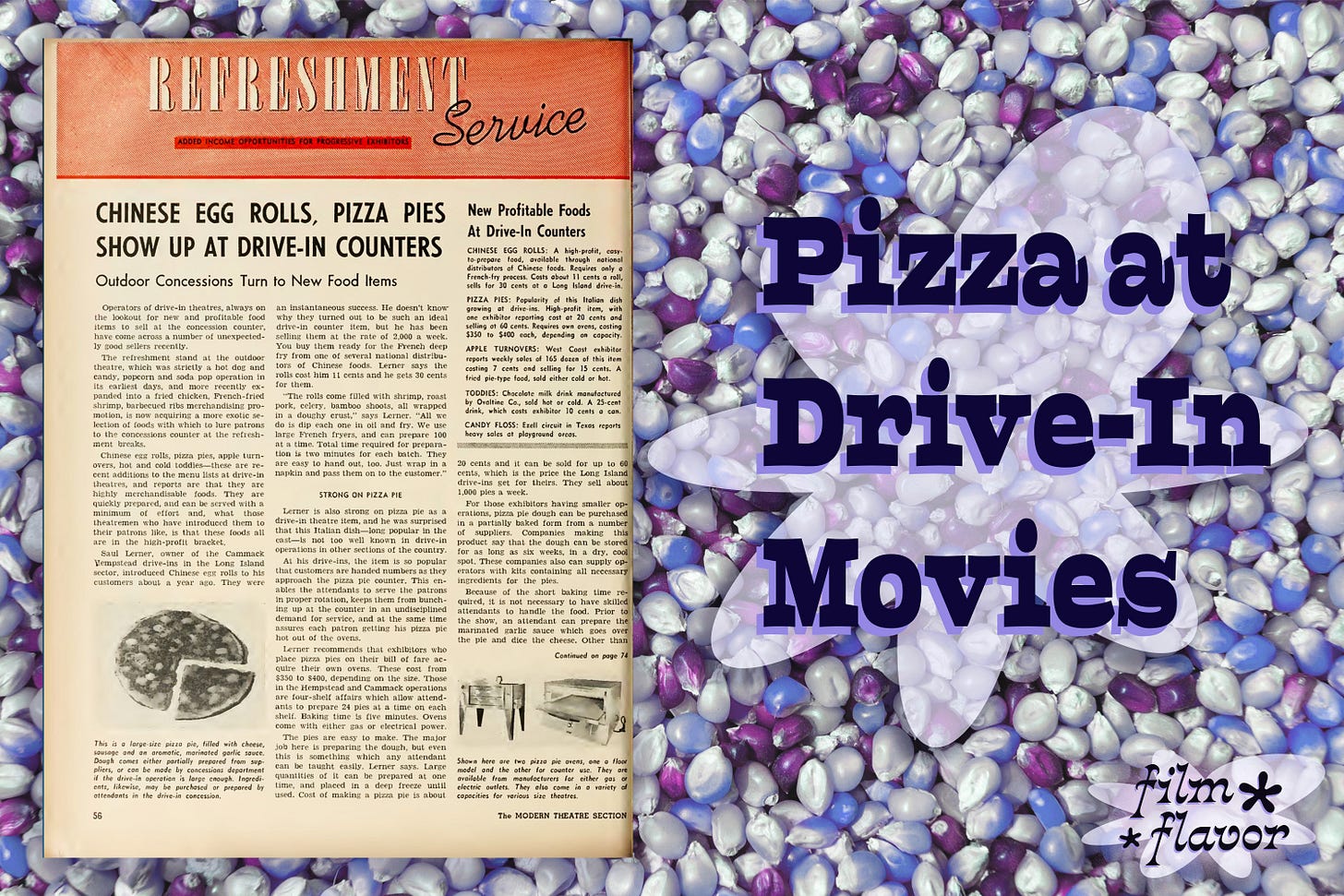
The concession snack advertisements didn’t stop at intermission reels.
“Not strictly for patron convenience, picnic tables were often found around the concession stand. It was felt these tables, with people sitting at them, prompted other patrons to get out of their cars and head for the snack bar.”
— Kerry Sergave, Drive-In Theaters: A History From Their Inception in 1933
One theater owner noted: “All our newspaper advertisements stress a come-out-for-dinner, bring the family theme.”
On those chillier nights when patrons didn’t want to leave their cars for a snack, theaters started bringing refreshments to the patrons.In the drive-in heyday, 44% of Chain-owned drive-ins offered car service, as did 23% of independently owned drive-in theaters. The Coca-Cola company even developed drive-in concession carts that held one hundred pounds of merchandise. The only reason this wasn’t more popular was likely due to the distraction: Snack push carts made a fair bit of noise on the often gravel car lots, and besides, there were more options at the main concession stand anyway.
As projection technology advanced, movie theater owners wanted to increase profits by squeezing more screenings into a day, and the movie intermission sadly died out. With three-and-a-half-hour films now commonplace, here’s hoping intermissions become a thing again in the coming years.
The Rise and Fall of Drive-In Movie Theaters
Despite concession profits, drive-in movie theaters were ultimately at the mercy of nature: Films could only be played with the sky was dark and the weather was nice, severely limiting drive-in schedules in comparison to indoor cinemas. Hollywood studios soon made it a habit of sending their new releases to indoor theaters first, leaving the drive-in theaters to play older releases.
It wasn’t long before some drive-in theaters began playing B-movies and unrated films, tarnishing the family-friendly atmosphere.
A Pearl-Clutching Concessions Ad: I am reasonably assuming this drive-in commercial I stumbled across in my research further tarnished the family friendly atmosphere.
Anecdotally, parents were afraid to send their teenagers off on drive-in dates: the privacy of the cars allowed for kids to get up to no good (see the public service announcement image above.) By the late 1970s, with television on the rise and drive-in movie theaters struggling, this classic pastime was winding down in popularity.
Drive-Ins Comeback Story: The COVID-19 Effect
From late-March through mid-August 2020, at the height of the COVID-19 pandemic lockdowns, drive-ins generated 85% of North American box office revenue. This was a far cry from that same period in 2019, when just 2.9% of box office revenue was accounted for by drive-ins. In the UK, the number of drive-in screens increased from 3 to 40 during the early months of the coronavirus pandemic.
While I know there was many pop-up drive-in theater screens set up during 2020 and 2021, most seemed to be run by otherwise indoor theaters that have since moved the party back to their place, and by consequence, the number of operating drive-in movie theaters in America has stayed roughly the same over the past five years, despite our newfound enthusiasm for the activity.
I personally saw Christopher Nolan’s Tenet at a pop-up Alamo Drafthouse drive-in movie theater in Ashburn, Virginia in 2020. Was I able to understand a word the characters were saying through my car speakers? Of course not! (The film’s sound mix is famously unintelligible even with proper speakers.) But was I able to order a vegan supreme pizza and popcorn to my automobile? You bet. The act of eating some delicious food while watching a movie on a big screen really lifted my spirits during those summer nights of the pandemic, and I’m grateful for everyone who staffed those drive-ins. Truly the Santa’s elves of COVID-19.
Drive-In Movie Theaters in the 21st Century and Beyond…
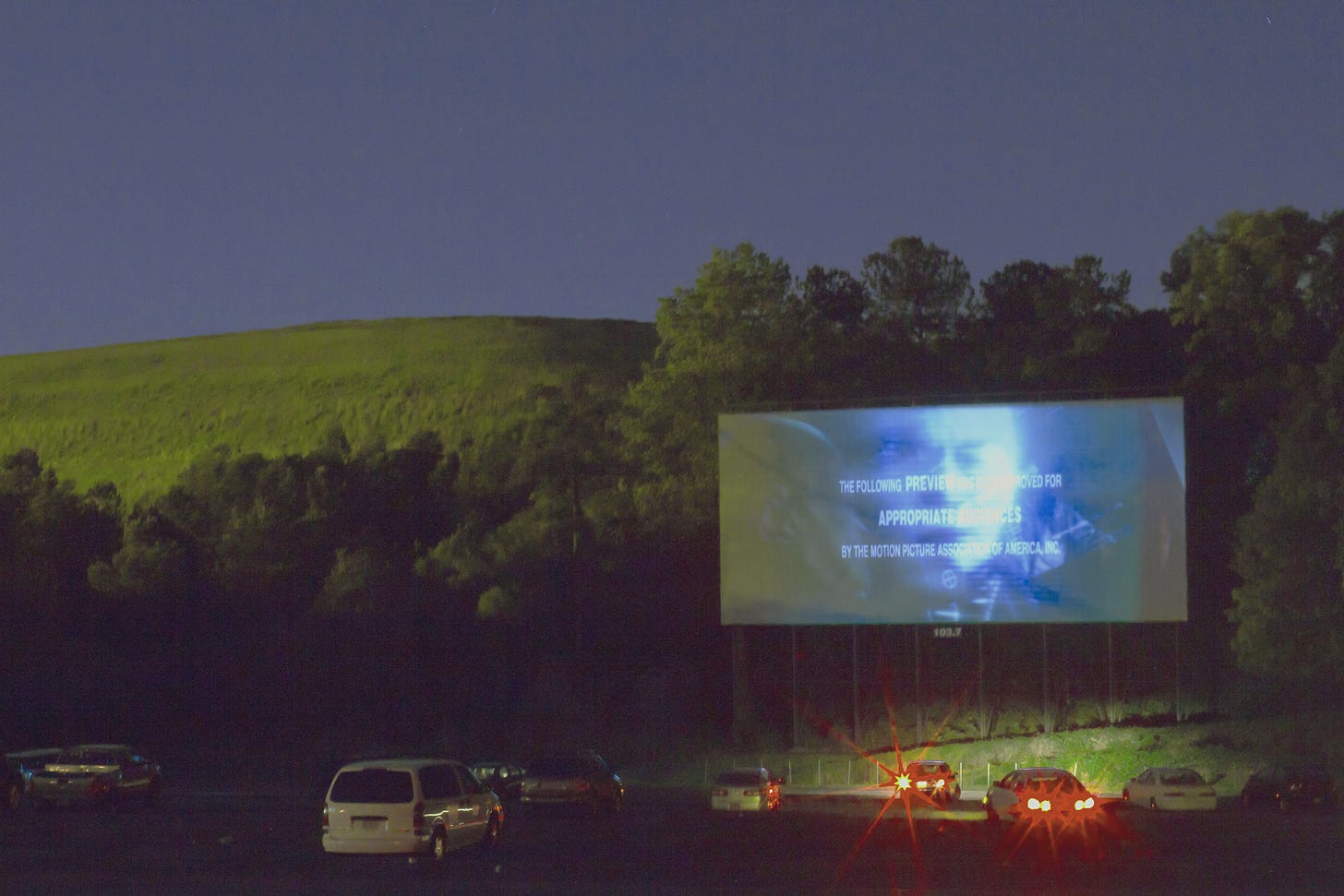
As of 2023 there were 299 drive-in movie theaters, sharing 510 screens, open today in the USA, per the United Drive-In Theatre Owners Association. While this number is nothing to sneeze at, I think we all agree we’d love to see a few more. Between land prices and start up costs, owning and operating a drive-in isn’t easy: If there’s a drive-in movie theater near you, make it a point to pay it a visit this summer season.
Next up in this series, you can expect:
Alcohol, Beer, Booze, and Soda at the Movies
Cinema Cafes
Pickles?
and…
The Vast History of Dine-In Movie Theaters
Until then, stay in your seats! (and stay subscribed!)
Disclaimer: Film Flavor is a newsletter written for entertainment purposes only. While I do my best to write meaningful posts with good intentions and cite sources when I have the bandwidth, I do not have the capacity nor the expertise to fact-check research as a trained professional journalist would. Despite my best efforts, the Film Flavor newsletter may contain omissions, errors, or mistakes and cannot be relied upon for accuracy or correctness. Additionally, I am not a chef, doctor, nutritionist, or food professional, and it is the responsibility of the reader to consult qualified professionals and use good judgement to decide whether the ingredients, foods, drinks, recipes, and cooking instructions mentioned within Film Flavor are safe to use, follow, or consume. The Film Flavor newsletter does not contain any professional advice or guidance and its contents should not be considered as such. Read the full Film Flavor disclaimer on the Film Flavor About Page, here. Thank you!
Further Reading:
The drive-in theater turns 90 today! Here are some of America's most cinematic from The Retrologist by Rolando Pujol
Drive-in Theaters: Photos of a Vanishing American Postime in LIFE Magazine
In Case You Missed It…
If you’re interested in more Film Flavor, please consider subscribing and sharing this post with friends and foes via the buttons below!
Leave a Comment and let me know: Have you ever been to a drive-in movie theater? What was your experience like?
I’d really love to swap nostalgic stories!
With gratitude,
Given the amount of traveling circuses and other entertainment popular at the turn of the 20th century from New Hampshire to Florida, I wouldn’t be surprised if another historian someday digs up additional proof of other drive-in movie theaters existing on the United States’ East Coast throughout the 20s. (Perhaps I will do this myself someday soon!)






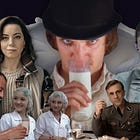
Thank you for these articles on earlier theater going experiences! They're so fascinating. Have you heard about fly-in theaters? I remember finding a short article on them once, but haven't been able to learn too much else about them. I can only imagine the potential chaos of such a thing.